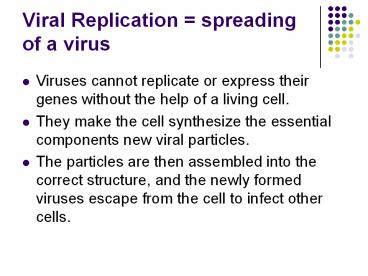Viral Replication = spreading of a virus - PowerPoint PPT Presentation
Title:
Viral Replication = spreading of a virus
Description:
Viral Replication = spreading of a virus Viruses cannot replicate or express their genes without the help of a living cell. They make the cell synthesize the ... – PowerPoint PPT presentation
Number of Views:127
Avg rating:3.0/5.0
Title: Viral Replication = spreading of a virus
1
Viral Replication spreading of a virus
- Viruses cannot replicate or express their genes
without the help of a living cell. - They make the cell synthesize the essential
components new viral particles. - The particles are then assembled into the correct
structure, and the newly formed viruses escape
from the cell to infect other cells.
2
Lytic Lysogenic Cycles of Viral Replication
3
Lytic Cycle
DNA/RNA is copied.
DNA/RNA injected into cell.
Virus attaches to cell.
Step 3
Step 2
Step 1
Virus copies itself.
Cell bursts (lyses) and releases new viruses.
Step 4
Step 5
4
LYTIC CYCLE
The virus attaches to bacteria (host)
The virus inserts its DNA
(enters the cell) into the bacteria The
virus takes over the cell's machinery
replicates in the host cell The virus
assembles itself. The virus
releases the host cell is destroyed
5
- LYTIC CYCLE
- The host cell dies
- EX common cold, Flu,
- rabies
6
LYSOGENIC CYCLE
- The host cell does not die immediately
- Viruses are latent (or dormant) within the host
cell and are usually integrated into the
chromosome - EX HIV, herpes
7
The virus binds to bacteria (host)
The virus inserts its DNA into the
bacteria The viral DNA gets
incorporated into the cell's chromosome
Viral DNA is replicated along with
chromosomal material Viruses can stay dormant
in your cells for years
8
Lytic vs. Lysogenic
9
Switching from Lysogenic to Lytic
- Once the virus is triggered, it comes out of its
dormant stage goes into the lytic cycle,
multiplying itself and destroying the host cell. - The exact cause of a trigger is still unknown in
eukaryotic cells. Sometimes it is heat (fever),
UV radiation - In prokaryotic cells, being exposed to UV
radiation is a trigger for the virus.
10
(No Transcript)































